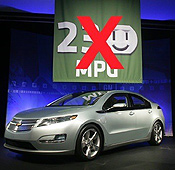Government Motors’ all-electric car isn’t all-electric and doesn’t get near the touted hundreds of miles per gallon. Like “shovel-ready” jobs, maybe there’s no such thing as “plug-ready” cars either.
The Chevy Volt, hailed by the Obama administration as the electric savior of the auto industry and the planet, makes its debut in showrooms next month, but it’s already being rolled out for test drives by journalists. It appears we’re all being taken for a ride.
When President Obama visited a GM plant in Hamtramck near Detroit a few months ago to drive a Chevy Volt 10 feet off an assembly line, we called the car an “electric Edsel.” Now that it’s about to hit the road, nothing revealed has changed our mind.
Advertised as an all-electric car that could drive 50 miles on its lithium battery, GM addressed concerns about where you plug the thing in en route to grandma’s house by adding a small gasoline engine to help maintain the charge on the battery as it starts to run down. It was still an electric car, we were told, and not a hybrid on steroids.
That’s not quite true. The gasoline engine has been found to be more than a range-extender for the battery. Volt engineers are now admitting that when the vehicle’s lithium-ion battery pack runs down and at speeds near or above 70 mph, the Volt’s gasoline engine will directly drive the front wheels along with the electric motors. That’s not charging the battery — that’s driving the car.
So it’s not an all-electric car, but rather a pricey $41,000 hybrid that requires a taxpayer-funded $7,500 subsidy to get car shoppers to look at it. But gee, even despite the false advertising about the powertrain, isn’t a car that gets 230 miles per gallon of gas worth it?
We heard GM’s then-CEO Fritz Henderson claim the Volt would get 230 miles per gallon in city conditions. Popular Mechanics found the Volt to get about 37.5 mpg in city driving, and Motor Trend reports: “Without any plugging in, (a weeklong trip to Grandma’s house) should return fuel economy in the high 30s to low 40s.”
Car and Driver reported that “getting on the nearest highway and commuting with the 80-mph flow of traffic — basically the worst-case scenario — yielded 26 miles; a fairly spirited backroad loop netted 31; and a carefully modulated cruise below 60 mph pushed the figure into the upper 30s.”
This is what happens when government picks winners and losers in the marketplace and tries to run a business. We are not told that we will be dependent on foreign sources like Bolivia for the lithium to be used in these batteries. Nor are we told about the possible dangers to rescuers and occupants in an accident scenario.
There’s the issue of asking grandma to use her electricity for the three or four hours necessary to recharge your car so you can get home to charge it again. Where’s the electricity going to come from considering that solar and wind don’t work when the sun don’t shine and the wind doesn’t blow? We aren’t building any nukes.
And since electricity rates are necessarily going to skyrocket as a result of this administration’s energy policies and fondness for cap-and-trade, what’s the true cost of operating a not-so-all-electric car like the Volt?
In 2008, candidate Obama pledged to put 1 million plug-in vehicles on the road by 2015. Not likely. It was a tough sell when we thought it was all-electric and could get 230 mpg. It will be a tougher sell now that we find it’s a glorified Prius with the price tag of a BMW that seats only four because of a battery that runs down the center of the car.
President Obama likes to talk about not giving the GOP back the keys to the car. It’s his industrial policy and central planning that have driven us into the ditch.
HT: IBD.

